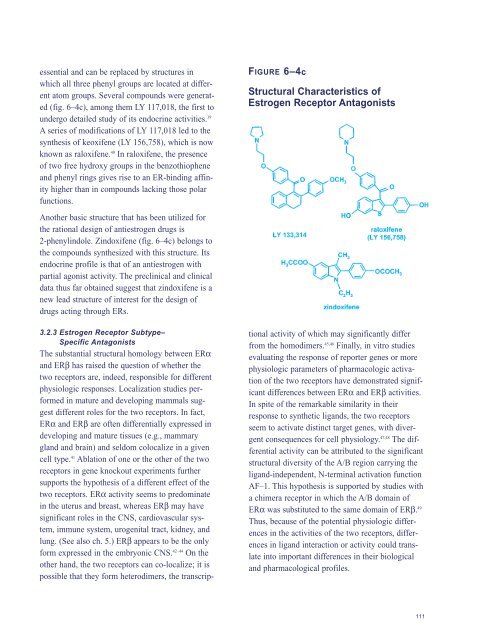WOMEN 'S HEALTH AND MENOPAUSE : - National Heart, Lung ...
WOMEN 'S HEALTH AND MENOPAUSE : - National Heart, Lung ...
WOMEN 'S HEALTH AND MENOPAUSE : - National Heart, Lung ...
You also want an ePaper? Increase the reach of your titles
YUMPU automatically turns print PDFs into web optimized ePapers that Google loves.
essential and can be replaced by structures in<br />
which all three phenyl groups are located at different<br />
atom groups. Several compounds were generated<br />
(fig. 6–4c), among them LY 117,018, the first to<br />
undergo detailed study of its endocrine activities. 39<br />
A series of modifications of LY 117,018 led to the<br />
synthesis of keoxifene (LY 156,758), which is now<br />
known as raloxifene. 40 In raloxifene, the presence<br />
of two free hydroxy groups in the benzothiophene<br />
and phenyl rings gives rise to an ER-binding affinity<br />
higher than in compounds lacking those polar<br />
functions.<br />
Another basic structure that has been utilized for<br />
the rational design of antiestrogen drugs is<br />
2-phenylindole. Zindoxifene (fig. 6–4c) belongs to<br />
the compounds synthesized with this structure. Its<br />
endocrine profile is that of an antiestrogen with<br />
partial agonist activity. The preclinical and clinical<br />
data thus far obtained suggest that zindoxifene is a<br />
new lead structure of interest for the design of<br />
drugs acting through ERs.<br />
3.2.3 Estrogen Receptor Subtype–<br />
Specific Antagonists<br />
The substantial structural homology between ERα<br />
and ERβ has raised the question of whether the<br />
two receptors are, indeed, responsible for different<br />
physiologic responses. Localization studies performed<br />
in mature and developing mammals suggest<br />
different roles for the two receptors. In fact,<br />
ERα and ERβ are often differentially expressed in<br />
developing and mature tissues (e.g., mammary<br />
gland and brain) and seldom colocalize in a given<br />
cell type. 41 Ablation of one or the other of the two<br />
receptors in gene knockout experiments further<br />
supports the hypothesis of a different effect of the<br />
two receptors. ERα activity seems to predominate<br />
in the uterus and breast, whereas ERβ may have<br />
significant roles in the CNS, cardiovascular system,<br />
immune system, urogenital tract, kidney, and<br />
lung. (See also ch. 5.) ERβ appears to be the only<br />
form expressed in the embryonic CNS. 42–44 On the<br />
other hand, the two receptors can co-localize; it is<br />
possible that they form heterodimers, the transcrip-<br />
FIGURE 6–4c<br />
Structural Characteristics of<br />
Estrogen Receptor Antagonists<br />
tional activity of which may significantly differ<br />
from the homodimers. 45,46 Finally, in vitro studies<br />
evaluating the response of reporter genes or more<br />
physiologic parameters of pharmacologic activation<br />
of the two receptors have demonstrated significant<br />
differences between ERα and ERβ activities.<br />
In spite of the remarkable similarity in their<br />
response to synthetic ligands, the two receptors<br />
seem to activate distinct target genes, with divergent<br />
consequences for cell physiology. 47,48 The differential<br />
activity can be attributed to the significant<br />
structural diversity of the A/B region carrying the<br />
ligand-independent, N-terminal activation function<br />
AF–1. This hypothesis is supported by studies with<br />
a chimera receptor in which the A/B domain of<br />
ERα was substituted to the same domain of ERβ. 49<br />
Thus, because of the potential physiologic differences<br />
in the activities of the two receptors, differences<br />
in ligand interaction or activity could translate<br />
into important differences in their biological<br />
and pharmacological profiles.<br />
111
















